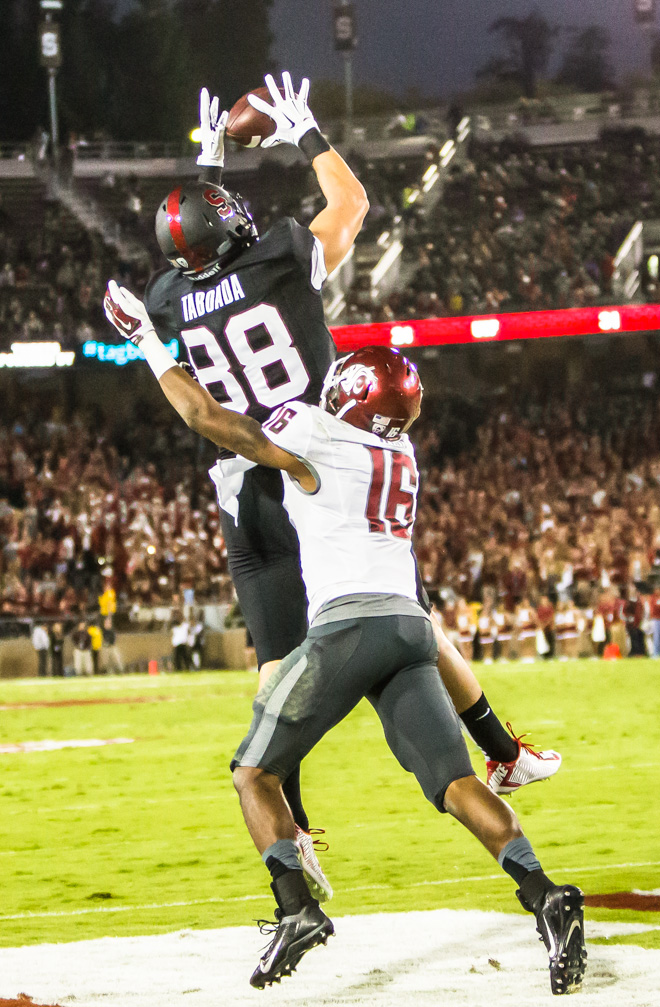On Friday night, the Cardinal welcomed the freshman class to campus with a win under the lights of Stanford Stadium. It wasn’t always pretty and it took well into the fourth quarter for Stanford to finally put the game out of the Cougars’ reach, but a sound defeat of any Pac-12 side this year is worthy of commendation.
The defense held WSU gunslinger Connor Halliday, one of the most prolific passers in college football, to a season-low 4.2 yards per play; the offense looked more like the one we’re used to in the David Shaw-era with an effective rushing attack paving the way for big passes from quarterback Kevin Hogan. Finally, after a few weeks of handing its opponents opportunity after opportunity, Stanford seemed to reestablish at least some of its typical control of the football game.
Let’s take a look at some numbers to break down this victory in a little more detail:
-29: The total rush yardage allowed by the Stanford defense, the lowest figure since the 1998 Big Game and the third lowest in school history. While Stanford’s secondary stole most of the headlines of the day with its stifling of Halliday, the defensive line was arguably even more impressive with its utter domination of the line of scrimmage. Stanford controlled the ground game in a fashion that gave Washington State no room to move forward.
Cardinal D held 509 ypg Connor Halliday to lowest passing all year: 292 yds on 69 att. Only game with more att: 70-734 vs. Cal. #gostanford
— Stanford Football (@StanfordFball) October 13, 2014
Much can be done to obscure the importance of this number, from calling attention to the past-first nature of Washington State’s offense to the usual disclaimer that rush yards include the negative yardage from sacks. However, the bottom line is that very few teams can manage a win while literally moving backwards on the ground. Washington State’s inability to run the ball forced them to test Stanford’s secondary again and again, and the unit did enough to rattle the Cougars’ receivers and limit scoring opportunities.
12: Number of players who caught at least one Kevin Hogan pass during the game. While big names like Ty Montgomery, Devon Cajuste and Michael Rector are still headlining the Cardinal’s air attack, Stanford coach David Shaw appears to be counting on a greater number of his talented receivers to move the ball down field. The results of this strategy were quite apparent, with tight ends Eric Cotton and Greg Taboada combining for three big touchdowns.
High-profile receivers like Montgomery and Cajuste attract huge amounts of attention from the opposing team’s secondary, which often prevents them from making some of the big plays they are capable of (especially in the red zone). This was especially true for Stanford’s offense, in which Hogan frequently attracted criticism for only looking to his one or two most-trusted names when making a pass. By spreading the ball around to a greater number of threats, Stanford gives all of its options a little more space to break free and ultimately put points on the board.
2: The number of times Kevin Hogan was sacked and hurried by Washington State’s pass defense. Stanford’s offensive line finally seemed to get things together, giving Hogan plenty of time to throw and creating holes for the running back committee to drive through the middle. Again, the quality of competition here wasn’t quite on the level of Oregon or UCLA, but the Cougars’ defensive line had managed a respectable 13 sacks headed into the game.
Stanford’s offensive line definitely has a long ways to go to match those of the last two years (as evidenced by the two holding penalties against linemen and a couple of false starts), but Friday’s performance signaled that progress is being made. If the unit can exercise some more discipline against a young Arizona State defense next weekend, it could make a big step toward showing that it’ll be ready for visits to Eugene and Los Angeles at the end of this season.
67: Stanford’s field goal percentage for the game. Nothing spectacular, especially with kicker Jordan Williamson’s miss coming from just 37 yards, but still a respectable performance.
Williamson has looked a little shaky thus far this year (with critical misses against USC and Notre Dame). On Friday he looked slightly more confident, finding the upright when it counted most in the fourth quarter. Given that Stanford rarely decides its games against its toughest opponents by huge margins, Williamson’s consistency will be incredibly important for the team if it wishes to defend its Pac-12 title and (possibly) squeak in to the first College Football Playoff. Hopefully his performance against Washington State will give him some of the confidence he needs so that he can perform in the way he is capable of.
Contact Andrew Mather at amather ‘at’ stanford.edu.
